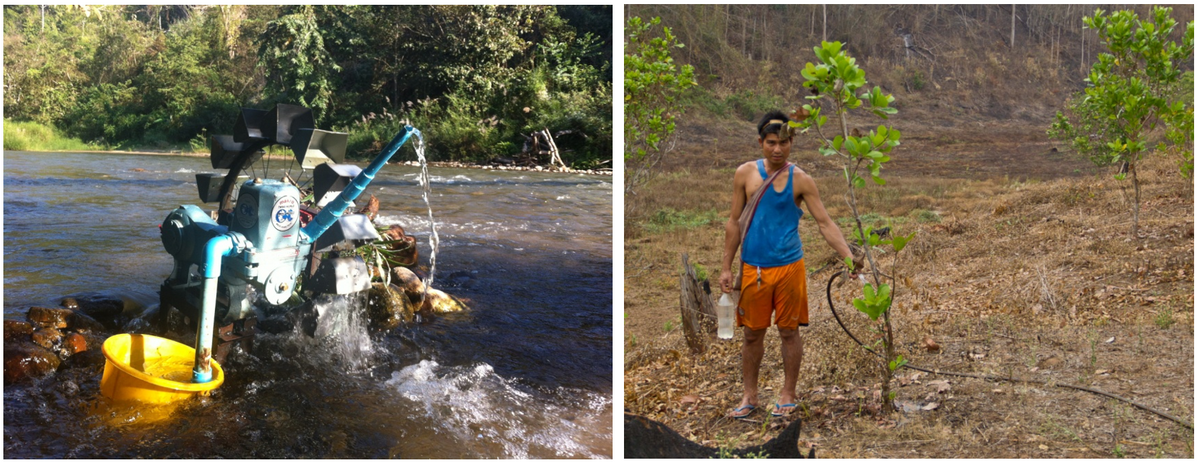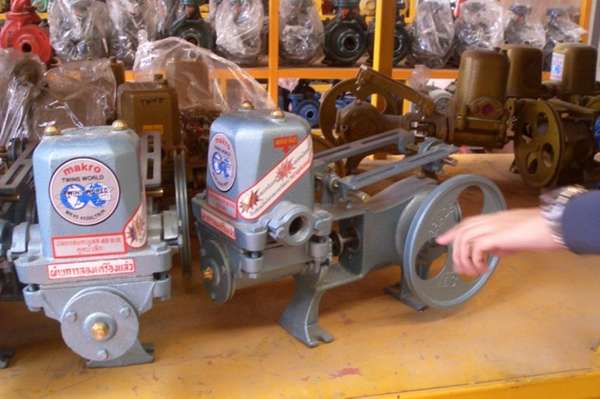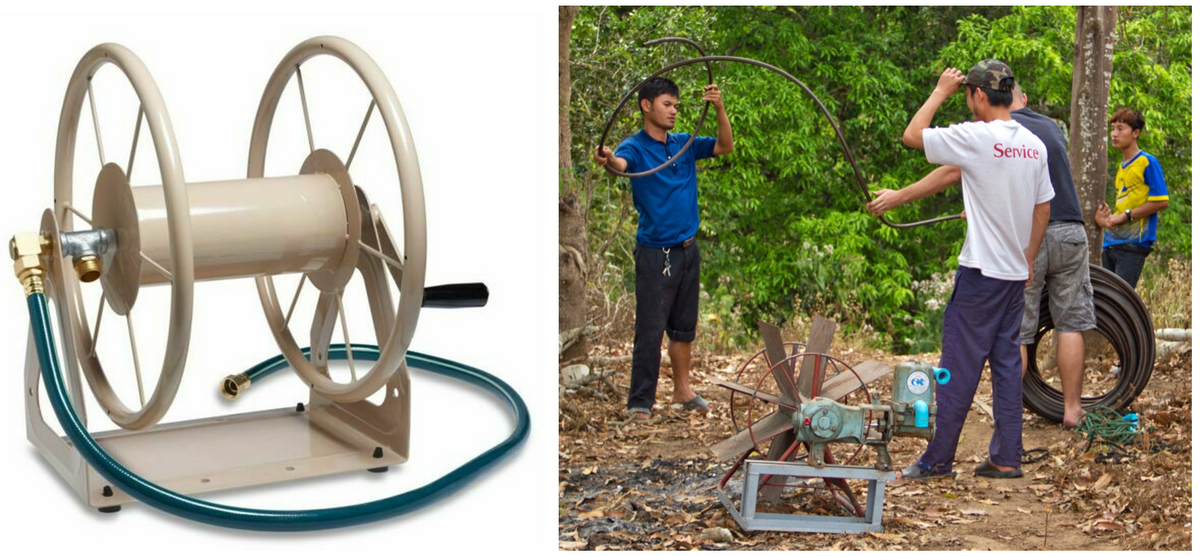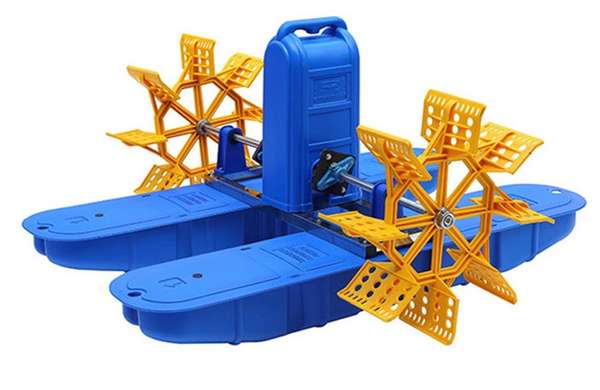[Editor’s Note: The Raintree Foundation is a small grass-roots organization in Northern Thailand, dedicated to helping underprivileged children and communities. In addition to hosting children’s homes, foster programs, and several small-scale social enterprises, Raintree is confronted with basic needs such as access to clean water, and seeks to find appropriate solutions to them.]

Initial Attempts
As we began looking into sustainable and alternative solutions for pumping water, our team began ‘playing around’ with the idea of water wheels for the supply of irrigation water to low elevation farmland. We initially began with research and testing of a pump called a Sling Pump, but gave up after testing several prototypes. Challenges included difficulty with DIY assembly, cost, specialized parts, and ultimately its efficiency.
Knowing that every pumping solution has its place and application, we decided to go another route and began looking into water wheel pumps. With the many design approaches out there, we decided to define our goals, and agreed that an appropriate design would feature affordability, easy assembly, low maintenance, and quick setup for people with access to flowing water. The overall objective was to help farmers with proximity to a river or small stream to irrigate their crops without the need for electric or gasoline powered pumps, as well as the reduction of manual labor.
To avoid starting from scratch we looked to the local hardware shop and decided to get a small 1 inch piston pump (Figure 2) off the shelf for around 2,400 THB (75 USD), along with a set of spare seals, bands, and piston for 260 THB (8 USD).

The next step was to design a wheel capable of driving the piston pump, solely by the flow of a small stream. Our first prototype featured an old bicycle wheel, which we had laying around, fixed with 14 used conveyor buckets attached (Figure 1). Attached to the outlet was a garden hose, while the inlet fed directly into the stream. Initially, this set-up enabled air into the pump inlet, so we used a strainer and a bucket with holes to provide a stable water level (Figure 1). The flow rate of the stream in this instance was approximately 0.6 to 0.8 m/s, so not too slow and not too fast. The elevation gain from the pump to the water storage tank uphill was approximately 6 meters, with a distance of approximately 50 meters. We calculated a roughly 3 liter per minute flow rate, more than adequate considering this pump would run 24 hours a day (~4,500 liters per day). In terms of cost, it certainly depends on availability of materials, but we calculated our set-up at 4,000 THB (125 USD).
Improving the Design
While our original prototype worked well overall, we felt that we could improve upon the buckets driving the wheel. We decided to modify the wheel using a simple hose reel used for ¼ inch chemical pipe. The reel itself cost 500 THB (15 USD) and already had the bearings, a basic frame, and a turn handle. To make the wheel spin by the flow of water from the stream we welded steel plates (roughly 2 mm thick) between the sides where the hose would typically sit (Figure 3).

We added a ½ inch PE (polyethylene) pipe to the pump and were able to start watering cashew trees 100 m away from the water source. The elevation was similar to the first site (~6 m in elevation gain) and the flow rate of the stream was similar as well. It quickly became apparent that the required distance was stretch for the pump, putting pressure on the piston pump, and sometimes caused it to stop entirely. The same would happen when raising the pipeline to higher elevations. With no control over the stream flow rate, we were limited in our ability to improve the work rate, but we have been successful in getting enough water to our trees each day for irrigation. Overall, this model was cheaper, and its larger surface area enabled longer pipelines capable of pumping water to greater elevations.
Additional Observations
It should be pointed out that the situating of the water wheel and pump in the water was one significant challenge that had to be overcome. It was challenging because the pump itself can’t be submerged totally due to its design, but the paddles need deep enough water to keep turning efficiently. After playing around for quite some time, we were able to find the right balance.
In addition, since our streams don’t flow particularly fast, we had to create a small canal to funnel the water. This helped to create a regular flow rate and a safe spot to run the pump (Figure 4). Finally, we found that in these areas where irrigation water is needed, these pumps can easily be placed into the stream by one individual, making them very convenient to use.

Taking a Different Approach
Since we had already purchased a piston pump we wanted to look into some kind of plug and play system. This time we explored the possibility of using a floating raft system (Figure 5). The cost of our next approach was much higher since the raft we used was not locally available. Because shrimp farming is not widely practiced in this area, the raft had to be shipped from the southern part of the country. Costs for the raft, frame, wheels, and bearings were about 12,000 THB (375 USD).

To adapt the system, we added a sprocket onto the paddle axle and connected it with a bigger sprocket to the belt axle. If I recall right we had a 50mm diameter sprocket at the pump shaft and a 150mm diameter sprocket at the raft axle.
This system was tested at another site, in another stream, during the rainy season. We estimated the water flow at this site was at least 1.2–1.5 m/sec. The major issue we encountered was the challenge of fixing the floating raft so it would stay in the middle of the stream. Unfortunately, fixing a steel cable along the side of the riverbank still allowed for the raft to move from side to side and outside of the stream’s flow. Another downside of the original shrimp farm aerator paddles were that they had holes for better aeration, but not helpful when attempting to harness the full power of the flowing water. In the end, we had trouble keeping the raft in place, while the stronger current made the nosedive in the front.
Conclusion
Despite our mediocre attempts, I am confident that we can find affordable solutions to meet the irrigation needs of farmers with proximity to flowing water.
